The River review — Without a paddle?
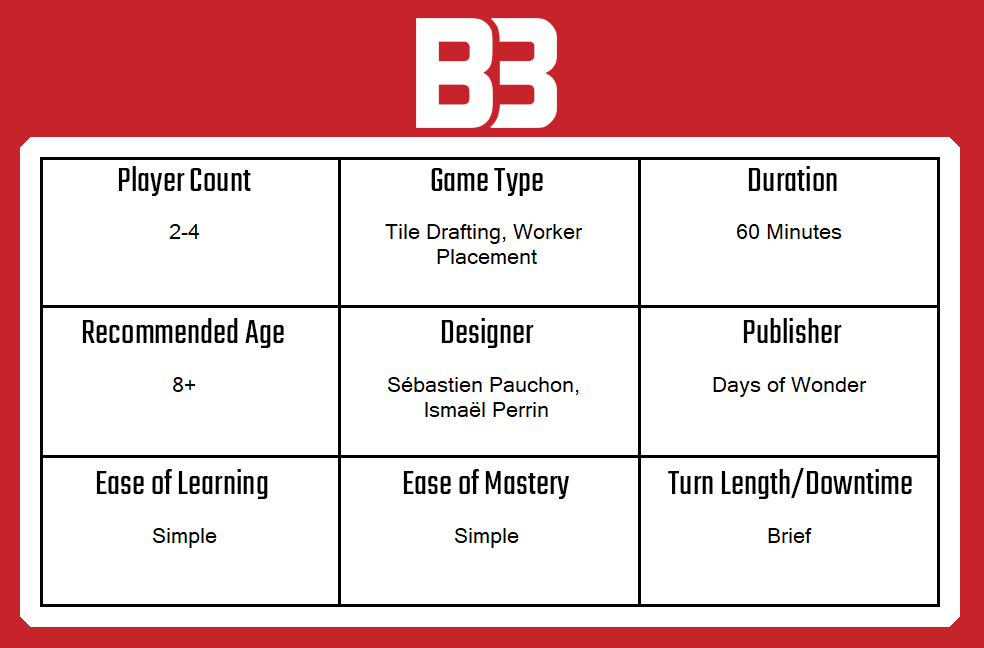
In The River, each player takes on the role of a newly elected Mayor, charged with developing a fledgling community along the banks of a prosperous river. The players draft tiles and place workers to collect resources and build up their town. In the end, the most prosperous town will be determined through the classic method of counting victory points. Do you think you’ve got the pioneering spirit of the Old West, or will your efforts be washed away?
Overview
The River is a brand new game from Days of Wonder that is clearly intended to be a relatively straightforward entry into the worker-placement genre. We’ve covered other simple worker-placement games before (such as Paleolithic, for example) but having played it several times, The River seems to offer a middle ground — simple to pick up, but with a hint of complexity around scoring, which does force a moderate level of strategic thinking.
Two to four players can enjoy The River . It is quick to set up and teach thanks to a very straightforward set of components and a brief instruction manual which uses examples and images well. The River features a central board with a number of worker-placement slots on it, as well as two stacks of exploration tiles, two stacks of victory-point tokens and a deck of building cards. There are also dedicated locations for all of the four sculpted wooden resources.
Play is based around the organisation and management of individual player boards, which are directly influenced by the players’ actions on the main board. Placing a worker to explore, for example, lets a player take one of the available exploration tiles to place on their board. This tile might have resources on it, which means that the player will then generate more resources of that kind when placing a worker on the matching resource space on the main board.
Other actions let players reserve building schematics or build structures directly from the board, each of which will generate a number of basic victory points, as well as bonus ones. Ultimately, after one player completes five buildings, all points will be added up across buildings and bonus tiles and via the small number of exploration tiles that enable additional scoring. Games usually last about an hour with fast and fluid play.
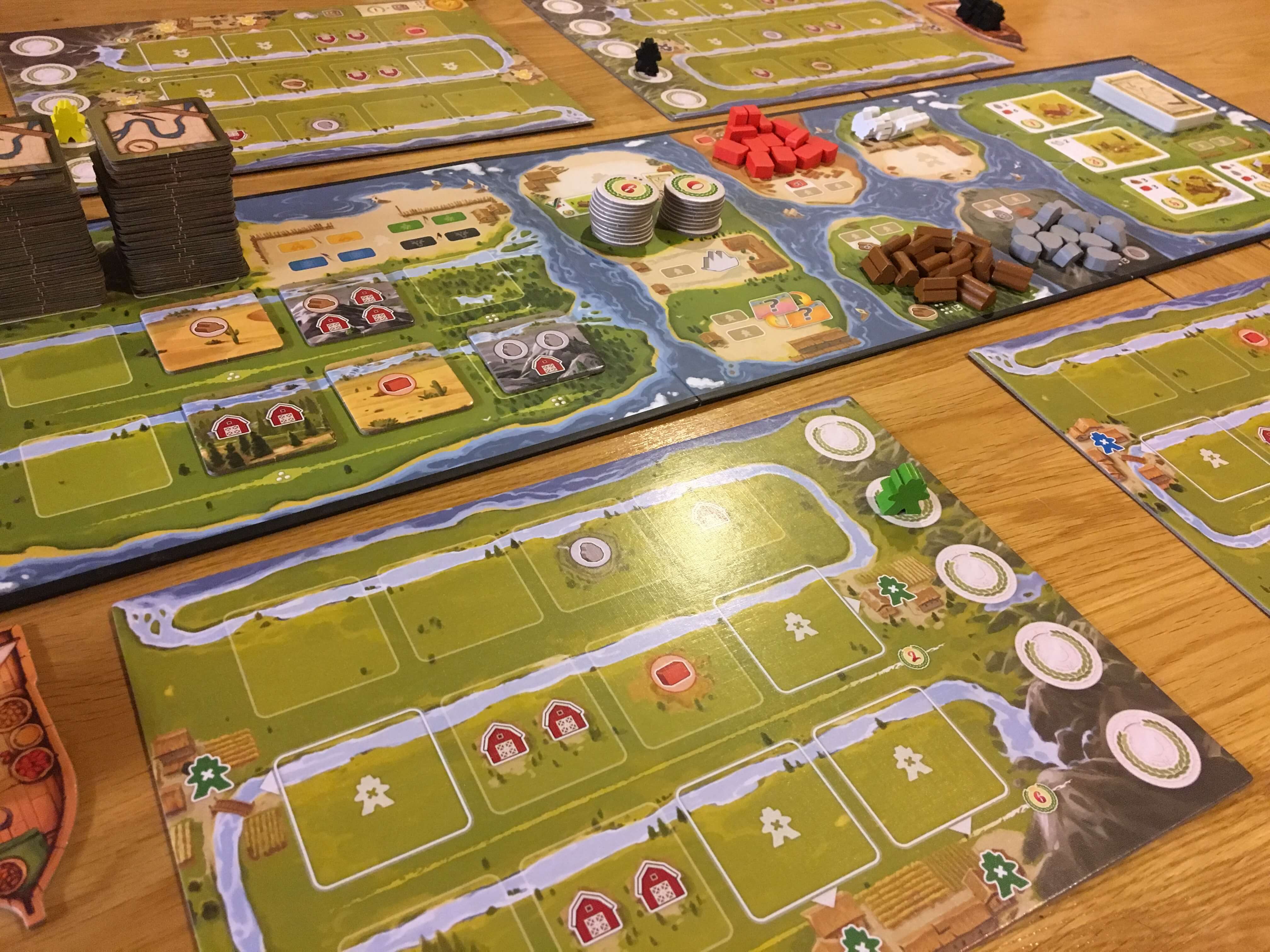
Components
The River’s components are attractive and intuitive. Its central board unfolds in three leaves to make a fairly long and slim centrepiece depicting the titular river, as well as all of the key worker-placement slots and spaces to store resources, exploration tiles and building cards. Each player also has a player board and a boat that holds four meeples of their colour, with a fifth meeple placed on a specific slot to the side.
All the wooden components are very nicely made, adding a tactile element to a game that seems to have quite a bit of ‘fondling’ in it. Players take the wooden bricks, stone, lumber and turkey pieces from the board and place them onto warehouse spaces on their board, which tends to result in them being picked up and fidgeted with on a regular basis. Thankfully, the pieces are uniformly cut and very robust, so their survival chances are high.
Similarly, the cardboard exploration tiles are excellent, with thick-cut cardboard cut so precisely that the river section shown on each matches perfectly with the section it overlays on the player boards. Other cardboard pieces like the bonus tokens and the actual player boards are very well made, too, which is great considering The River will attract younger players, who might end up taking less care than older gamers. The building card deck is a little unexciting, but entirely functional — personally, I would like the buildings to be represented by tiles instead, but I’ll talk about that later.
Finally, a note on artwork and the quality of the instruction manual. Firstly, as this is a Days of Wonder game, it has similar, distinctive artwork that is uniform across the box, the manual and all of the other components that make it immediately eye-catching. I would defy almost anyone to walk past The River on a shelf and not at least be curious about what the gorgeous box contains. Secondly, the manual is about five pages long and very clearly laid out. There are two or three ambiguous rules, but nothing you can’t work around just by interpreting what you can see on the board and the other materials.
Thanks to how it looks and how well it captures the player’s attention and holds it, The River is therefore an appealing way to expand your collection to accommodate slightly heavier gateway games. This is exactly the kind of visual approach that Days of Wonder has taken across their entire range, so fans of their other products will not be disappointed.
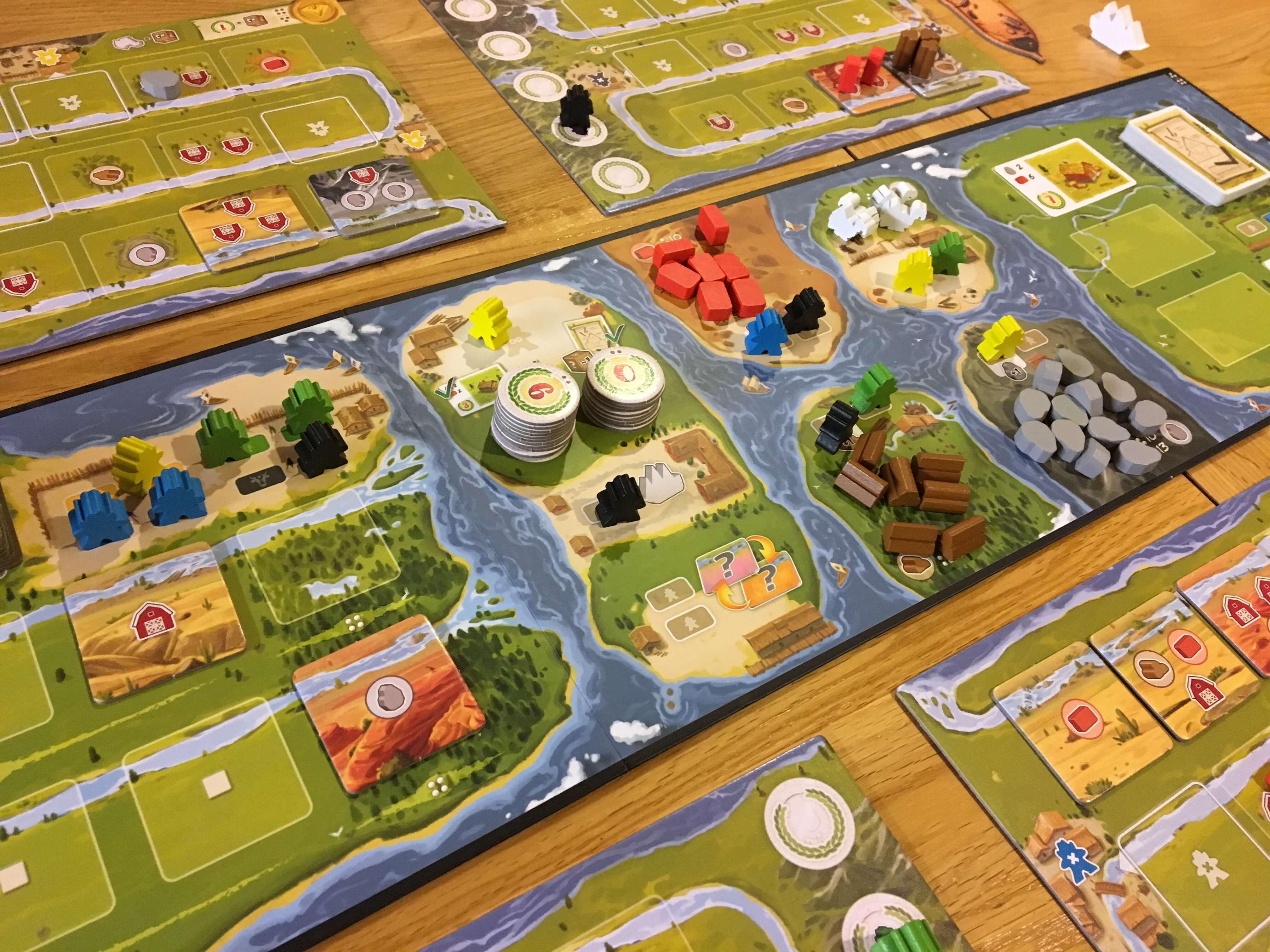
Turn structure
Each turn in The River is likely to last less than a minute thanks to the simple choices and fairly straightforward decisions involved. First of all, the game is based on a series of rounds, with each round ending when all of the players have placed their workers. Each turn within a round is a simple case of placing one worker on one of the available locations, then taking the associated action. The game ends at the end of the round in which one player builds their fifth building and places the associated bonus token onto their board — this gives the other players a little time to close out any unfinished business of their own.
The kind of worker-placement actions available are very straightforward and include things like placing a worker on one of the resource spaces, then taking a number of resources equal to the number of matching resources on the player board. The most interesting action is probably exploration, which has the player choose one of the tiles available on the board. When a player does this, they take the chosen tile and place it into the next space on their own board, taking into consideration the fact that it will replace whatever is shown on the space it overlays.
Whilst buildings (which are constructed by spending the collected resources and placing a worker, then tucking the card you’ve built under your player board) score the majority of points in a game of The River, there are benefits to exploring. This is especially true if the players can arrange their board to include vertical patterns of matching tiles or fill up the lower rows of the board, where there are bonuses that increase based on the level of completion.
There are a number of other things to consider in The River that affect the way turns play out. For example, players need to ensure they take enough exploration tiles with warehouses on them if they want to store all their resources. They’ll also notice that as their player board fills out, their workers begin to ‘settle’, at which point they are no longer available for further use. As such, there’s a fine balance to be struck between rushing ahead and hanging back. On the same note, the initial stack of victory point tokens is each worth zero points, but the second one a player adds to their board unlocks a worker — so the opposite logic applies.
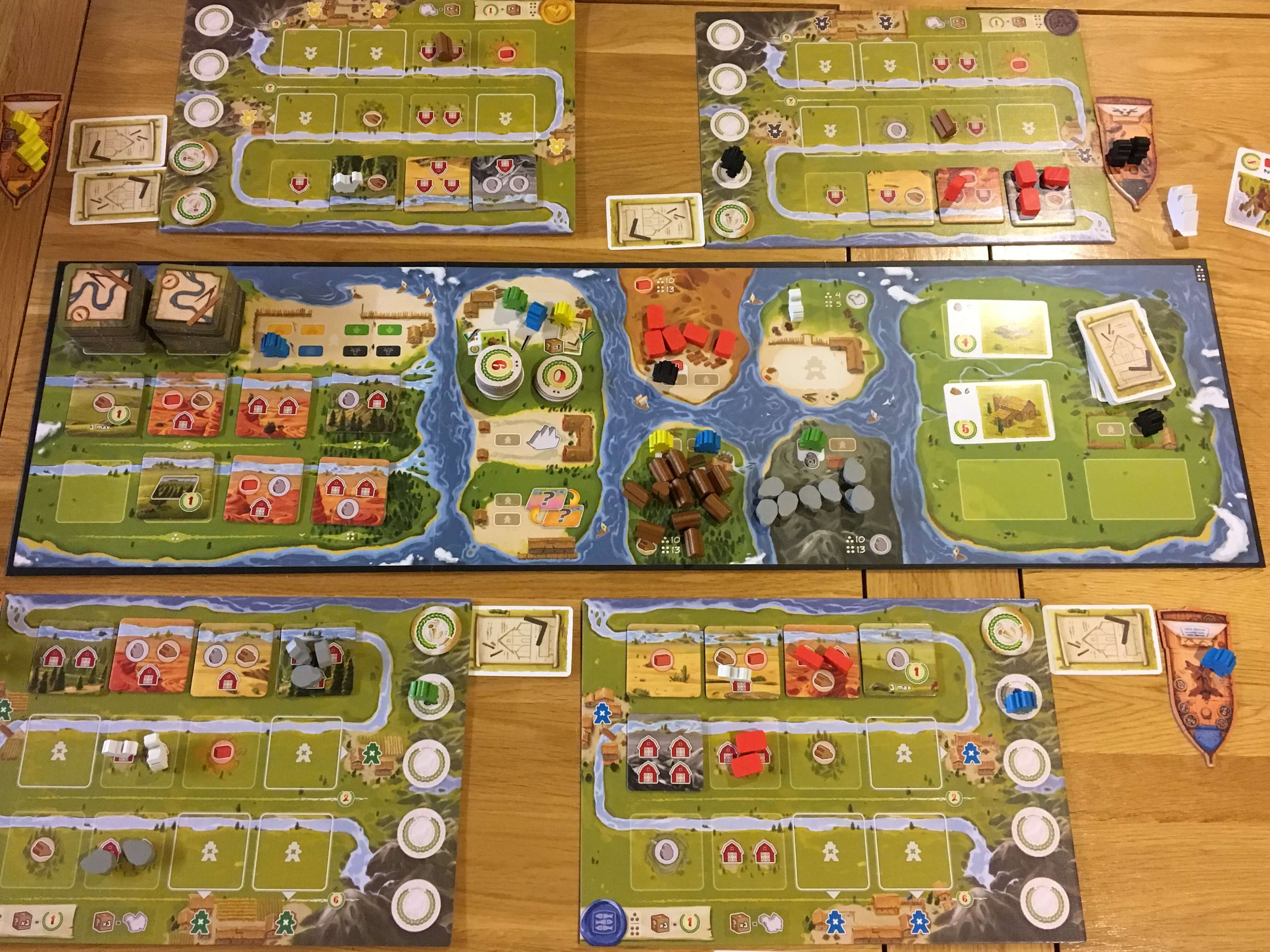
Game experience
That’s the game, really, in The River. I think that if it were simply a case of placing workers and taking actions, it could be classed as an outright gateway game and I might even suggest it was a fairly dull one. The fact that it introduces a couple of thematic decision-making elements around when workers are either added or removed and different bonuses depending on the timing of building construction does add a few strategic subtleties that aren’t usually present in lighter games. The relatively gentle feel of The River continues in the fact that there are no direct interactions — only ways in which players can lock each other out of the best action spaces.
I do like the flow of gameplay in The River (no pun intended) because of how fast and fluid it is. Even when you do need to make tough decisions (such as planning a sequence of actions over several turns), they are never so hard that analysis paralysis becomes a major issue, even for new players. This makes The River a fairly simple game to teach, which is always very welcome in my household where there are kids, light gamers and often, friends who don’t game at all. Getting people to the table is made much easier by how good The River looks both in and out of the box and I’d say that it’s one of the most attractive worker-placement games I’ve played in a long time.
A slight downside is that The River is fairly light and it’s unlikely to appeal as much to players who enjoy games of, say, mid weight or higher. Yes, there are decisions to make, but none of them feel quite as game changing as they do in other games of this genre. I also question the decision to include building cards, instead of having buildings take up space on the players’ individual boards. If the latter approach was used, there would be even greater need for strategic decision making (although complexity would increase and there would probably be a need for bigger boards).
In general (and especially if it suits your player group), I’d say The River is an enjoyable experience — and that’s really thanks to the way it links simple gameplay with thematic elements and exceptional visual appeal. The fact that settlers are first attracted to the towns and then, after contributing, begin to drift away, feels quite nice in a thematic sense, as does the rush for bonus building points around halfway through the game. These features are understated, but present all the same. There’s even a solo mode that requires, minimal rules changes, if that’s your bag.
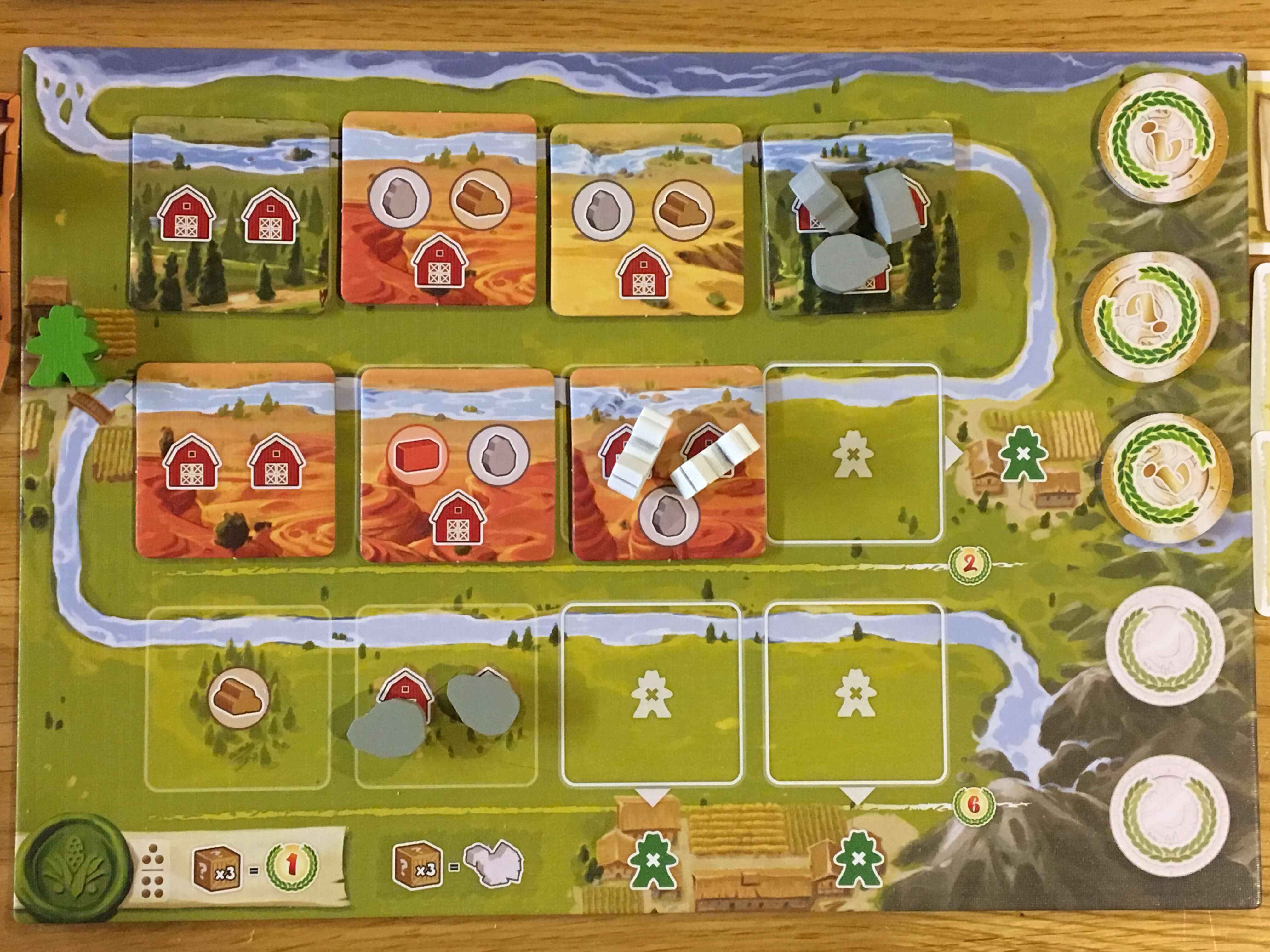
Conclusion
There is definitely a place in my collection for games that verge on the lighter side, yet still offer at least some strategy and complex decision making. It helps when such games are made to be as easy to pick up and play as The River, with its quick, simple turns and exceptional looks.
The River isn’t the most tactically deep (I’m still not punning intentionally) of efforts, but that’s okay — it’s still huge fun, in particular when played with the full complement of four players. On that note, there are balancing features for all player counts, but the rules are not materially more complex to accommodate them. The flexibility, fast pace and enjoyable gameplay make The River an enjoyable enough game for me, though how it stands up to longer-term play, we’ll have to wait and see.
A copy of The River was provided for review purposes and can be purchased via 365 Games or through one of the shops found in this handy Store Locator.
Comments are closed.